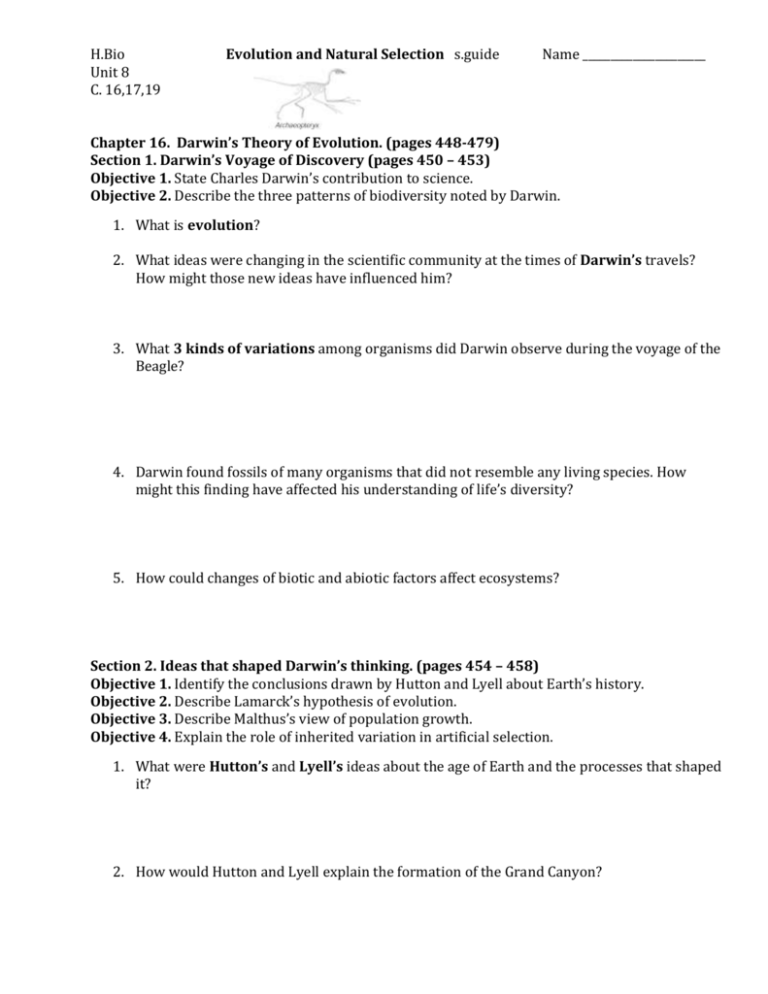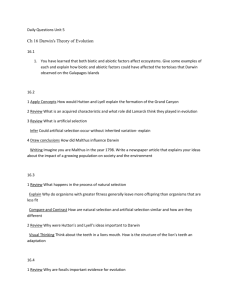H.Bio Unit 8 Evol. study guide
advertisement

H.Bio Unit 8 C. 16,17,19 Evolution and Natural Selection s.guide Name ______________________ Chapter 16. Darwin’s Theory of Evolution. (pages 448-479) Section 1. Darwin’s Voyage of Discovery (pages 450 – 453) Objective 1. State Charles Darwin’s contribution to science. Objective 2. Describe the three patterns of biodiversity noted by Darwin. 1. What is evolution? 2. What ideas were changing in the scientific community at the times of Darwin’s travels? How might those new ideas have influenced him? 3. What 3 kinds of variations among organisms did Darwin observe during the voyage of the Beagle? 4. Darwin found fossils of many organisms that did not resemble any living species. How might this finding have affected his understanding of life’s diversity? 5. How could changes of biotic and abiotic factors affect ecosystems? Section 2. Ideas that shaped Darwin’s thinking. (pages 454 – 458) Objective 1. Identify the conclusions drawn by Hutton and Lyell about Earth’s history. Objective 2. Describe Lamarck’s hypothesis of evolution. Objective 3. Describe Malthus’s view of population growth. Objective 4. Explain the role of inherited variation in artificial selection. 1. What were Hutton’s and Lyell’s ideas about the age of Earth and the processes that shaped it? 2. How would Hutton and Lyell explain the formation of the Grand Canyon? 3. What is an acquired characteristic? What role did Lamarck think acquired characteristics played in evolution? 4. What parts of Lamarck’s hypotheses have been proved wrong? What did Lamarck get right? 5. According to Malthus, what factors limit human population growth? How did he influence Darwin? 6. What is artificial selection? Could artificial selection occur without inherited variation? Explain. Section 3. Darwin presents his case (page 460 – 464) Objective 1. Describe the conditions under which natural selection occurs. Objective 2. Explain the principle of common descent. 1. What happens in the process of Natural Selection? 2. Why do organisms with greater fitness generally leave more offspring than organisms that are less fit? 3. How are natural selection and artificial selection similar and different? 4. Why were Hutton’s and Lyell’s ideas important to Darwin? 5. What do evolutionary trees show? What does a tree of life imply about all species living and extinct? Section 4. Evidence of Evolution. (pages 465 – 473) Objective 1. Explain how geologic distribution of species relates to their evolutionary history. Objective 2. Explain how fossils and the fossil record document the descent of modern species from ancient ancestors. Objective 3. Describe what homologous structures and embryology suggest abot the process of evolutionary change. Objective 4. Explain how molecular evidence can be used to trace the process of evolution. Objective 5. Explain the results of the Grants’ investigation of adaptation in Galapagos finches. 1. What is biogeography? 2. Why do distantly related species in very different places sometimes share similar traits? 3. Why are fossils important evidence for evolution? 4. Describe how a modern mysticete whale is different from Ambulocetus. 5. How do vestigial structures provide evidence for evolution? 6. Explain the difference between homologous and analogous structures. Which are more important to evolutionary biologists? Why? 7. What is the relationship between Hox genes and embryological development? 8. Organisms A and B have similar HOx genes, and their embryos, in the earliest stage of development, are also very similar. What do these similarities indicate about the ancestry of organisms A and B? 9. What hypothesis have the Grants been testing? 10. How do the Grant’s data show that genetic variation is important in the survival of a species? Chapter 17 Evolution of Populations (pages 481 – 507) Section 1. Genes and Variation (pages 482-486) Objective 1. Define evolution in genetic terms. Objective 2. Identify the main sources of genetic variation in a population. Objective 3. State what determines the number of phenotypes for a trait. 1. Define gene pool and allele frequency. 2. Explain, in genetic terms, what indicates that evolution is occurring in a population? 3. List three sources of genetic variation. 4. How does genetic recombination result in genetic variation? 5. Why does sexual reproduction provide more opportunities for genetic variation than asexual reproduction? 6. What is a single gene trait? What is a polygenic trait? How does the range of phenotypes differ for each? 7. How are mutations important in the process of evolution? Section 2. Evolution as Genetic Change in Populations. (pages 487 – 492) Objective 1. Explain how natural selection affects single gene and polygenic traits. Objective 2. Describe genetic drift. Objective 3. Explain how different factors affect genetic equilibrium. 1. How does natural selection affect a single-gene trait? 2. Compare the three types of polygenic selection: Directional, Stabilizing, Disruptive. 3. Define genetic drift. 4. How can the founder effect lead to changes in a gene pool? 5. What 5 conditions are necessary to maintain genetic equilibrium? (Hardy-Weinberg equation) 6. Why is genetic equilibrium uncommon in actual populations? Section 3. The Process of Speciation (pages 494 – 497) Objective 1. Identify the types of isolation that can lead to the formation of new species. Objective 2. Describe the current hypothesis about Galapagos finch speciation. 1. What is geographic isolation? 2. A newly formed lake divides a population of a beetle species into two groups. What other factors besides isolation might lead to the two groups becoming separate species? 3. What types of reproductive isolation may have been important in Galapagos finch speciation? 4. Explain how the vegetarian tree finch, which feeds on fruit, might have evolved. 5. How is a time a factor in Temporal isolation? Section 4. Molecular Evolution. (pages 498 – 501) Objective 1. Explain how molecular clocks are used. Objective 2. Explain how new genes evolve. Objective 3. Describe how Hox genes may be involved in evolutionary change. 1. What is a molecular clock? 2. Why do molecular clocks use mutations that have no effect on phenotypes? 3. How can crossing over result in gene duplication? 4. Why is gene duplication important in evolution? 5. Use the evolution of the insect body plan to explain the significance of Hox genes in evolution. 6. In evolution, why have small changes in Hox genes had a great impact? Chapter 18 Classification. Unity and Diversity of Life. (pages 508-535) Section 1. Finding Order in Diversity (pages 510 – 515) Objective 1. Describe the goals of binomial nomenclature and systematics. Objective 2. Identify the taxa in the classification system devised by Linnaeus. 1. Identify two goals of systematics. 2. Why do the common names of organisms often cause problems for scientists? Give two examples. 3. Pick a scientific name (i.e. Felis leo ) and describe what each part means. 4. State the ranks of in Linnaean system of classification, beginning with the smallest. 5. How does the similarity of organisms change as you proceed down the taxa from kingdom? 6. Why is species the only “natural” rank in classification? Section 2. Modern Evolutionary Classification (pages 516 – 522) Objective 1. Explain the difference between evolutionary classification and Linnaean classification. Objective 2. Describe how to make and interpret a cladogram. Objective 3. Explain the use of DNA sequences in classification. 1. How does evolutionary classification differ from traditional classification? 2. To an evolutionary taxonomist what determines whether two species are in the same genus? 3. What is a derived character? 4. Along any one lineage, what do the locations of derived characters on a cladogram show? (use figure 18-9 on page 519) 5. How do taxonomists use the DNA sequences of species to determine how closely two species are related? 6. Why has the classification of American vultures changed? 7. Examine the cladogram. Z Y X a. Which groups - X and Y, or X, Y and Z – have the most recent common ancestor? b. Which species – X and Y, or X and Z - share more derived characters? Section 3. Building the Tree of Life (pages 523 – 528) Objective 1. Name the 6 kingdoms of life. Objective 2. Explain what the tree of life represents. 1. Name the 6 kingdoms. 2. Why did systematists establish the domain? 3. Why did systematists split the Monerans into two kingdoms? 4. What are the three domains of life? 5. Why are quotes used for the kingdom “Protista”? 6. The table below compares some of the molecular characteristics of organisms in the three domains. Molecular Characteristic Domain Bacteria Archaea Eukarya Introns (parts of genes that do not code Rare Sometimes present Present RNA polymerase One type Several types Several types Not present Present Present Unbranched Some branched Unbranched Histones found with DNA Lipids in cell membrane a. Which domains have unbranched lipids in their cell membranes? b. Which domain has just one type of RNA polymerase? c. On the basis of this table, how are archaea different from bacteria? Chapter 19 History of Life (pages 536 – 570) Section 1. The Fossil Record (pages 538 – 545) Objective 1. Explain what information fossils can reveal about ancient life. Objective 2. Differentiate between relative dating and radiometric dating. Objective 3. Identify the divisions of the geologic time scale. Objective 4. Describe how environmental processes and living thins have shaped life on Earth. 1. What can a paleontologist learn from fossils? 2. Why have so few organisms become fossilized? 3. What are the two ways that geologists determine the age of fossils? 4. Many more fossils have been discovered since Darwin’s day. How would this information make relative dating more accurate? 5. How are era’s and periods related? 6. Use figure 19-5 (page 542) to determine when the Devonian period began and how long it lasted. 7. Describe the three processes that have affected the history of life on Earth. 8. Describe two ways in which continental drift has affected organisms. 9. Look at the fossil in the photograph below. Describe the fossil. What can you infer about how the organism moved? Explain your answer. Section 2. Patterns and Processes of Evolution. (pages 546 – 552) Objective 1. Identify the processes that influence survival or extinction of a species of clade. Objective 2. Contrast gradualism and punctuated equilibrium. Objective 3. Name two important patterns in macroevolution. Objective 4. Explain the evolutionary characteristics of coevolving organisms. 1. How does variation within a clade affect the clade’s chance of surviving environmental change? 2. How is mass extinction different from background extinction? 3. Explain how punctuated equilibrium is different from gradualism. 4. Why would evolution speed up when a small group of organisms migrates to a new environment? 5. What is adaptive radiation? When might adaptive radiation result in convergent evolution? 6. What is coevolution? Describe an example. 7. What role does the environment play in convergent evolution? Section 3. Earth’s Early History (pages 553 – 558) Objective 1. Identify some of the hypotheses about early Earth and the origin of life. Objective 2. Explain the endosymbiotic theory. Objective 3. Explain the significance of sexual reproduction in evolution. 1. What was Earth’s early atmosphere like? 2. What does Miller and Urey’s experiment tell us about the organic compounds needed for life? 3. Could life arise from nonlife today? Why or why not? 4. What does the endosymbiotic theory propose? How did mitochondria evolve? What evidence supports that theory? 5. Why is the development of sexual reproduction so important in the history of life? 6. Put the following events in the order in which they occur. Development of eukaryotic cells, sexual reproduction, life on the land, free oxygen in the atmosphere, development of photosynthesis, microsphere formation









